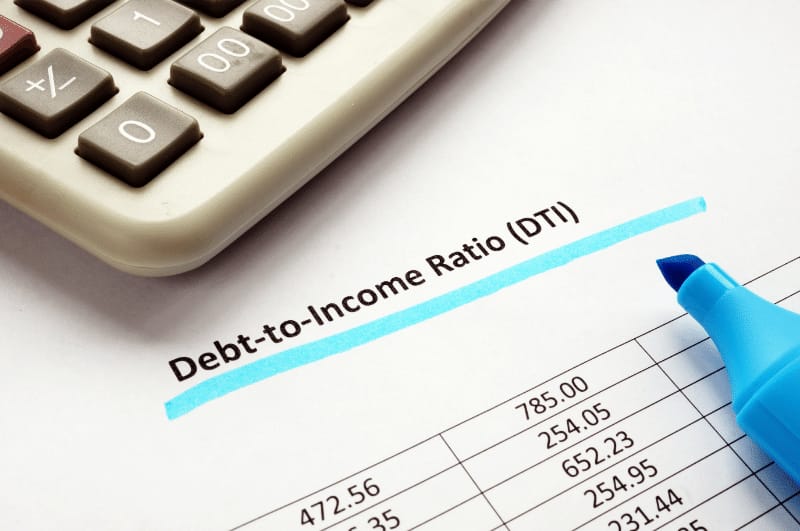Do you know how your financial health and borrowing potential are influenced by a single percentage? Understanding the significance of your debt-to-income (DTI) ratio is crucial to navigating the world of loans and credit. In this blog post, we will dissect the concept of DTI, explore its impact on credit scores and mortgage approvals, and provide strategies to improve your financial standing. Are you ready to take control of your financial future and learn what is a good debt to income ratio? Let’s dive in!
Short Summary
Debt-to-Income Ratio (DTI) is a key factor in determining an individual’s financial stability and ability to repay debt.
A “good” DTI ratio is Recommended to be below 35%, with lower ratios signaling responsible financial management.
Strategies such as aggressively repaying debt, increasing income, adding co-signers/additional borrowers can help improve your DTI ratio for better loan terms.
Understanding Debt-to-Income Ratio

Imagine lenders as detectives, sifting through heaps of financial information to determine whether you’ll be able to repay your debts. One critical piece of evidence they rely on is your debt-to-income ratio (DTI). This ratio compares your monthly debt payments to your gross monthly income, painting a picture of your financial stability for lenders. In essence, a good DTI ratio implies that you’re more likely to manage your monthly payments and repay borrowed money on time.
So, how do lenders assess this vital metric? They typically use two types of DTI ratios: front-end and back-end. These ratios help lenders gauge the proportion of your income allocated to housing expenses, credit cards, personal loans, and other debts.
Types of DTI Ratios
The front-end DTI ratio, often called the housing ratio, zeroes in on housing expenses in relation to your monthly gross income. It takes into account costs such as rent or mortgage payments, property taxes, and homeowners’ insurance premiums. On the other hand, the back-end DTI ratio casts a wider net, encompassing all monthly debt payments. Lenders focus on the back-end ratio because it provides a holistic view of your financial obligations, including personal loans, auto loans, and credit card payments.
In a nutshell, the front-end DTI ratio highlights your ability to manage housing costs, while the back-end ratio reveals how well you juggle all your debts. Together, these ratios help lenders determine if you’re a reliable borrower.
Ideal Debt-to-Income Ratios

What constitutes a good debt-to-income ratio? This is an important question to ask. For mortgage approval, it’s generally recommended to have a front-end DTI below 28% and a back-end DTI below 36%. However, a “good” overall DTI ratio is usually below 35%. If your DTI falls between 36% and 49%, you’re still in a manageable range, but it’s wise to take steps to lower your debt, such as paying off credit cards or consolidating loans.
Bear in mind that these numbers may vary depending on loan type and lender. The Consumer Financial Protection Bureau (CFPB) suggests capping your back-end DTI ratio at 43%. Lenders may be more flexible with borrowers who have excellent credit or substantial savings, but it’s always best to aim for a lower DTI.
Maintaining a low DTI not only improves your chances of mortgage approval, but also demonstrates responsible financial management. A lower DTI ratio signals to lenders that you’re less of a risk, which can lead to better borrowing terms and interest rates.
Calculating Your Debt-to-Income Ratio

Now that you understand the importance of DTI, it’s time to crunch the numbers and calculate your own ratio. To do so, start by tallying up your total monthly debt payments, including rent or mortgage, credit card bills, auto loans, and other recurring financial obligations. Next, divide this sum by your gross monthly income – that is, your income before taxes and deductions. Finally, multiply the result by 100 to convert it into a percentage, and voilà, you have your DTI ratio.
For example, to calculate debt to income, if your total monthly debt payments, including credit card debt and monthly mortgage payment, amount to $2,000 and your gross monthly income is $5,000, your DTI ratio would be 40% (monthly debt payments divided by $5,000 = 0.4 x 100 = 40%). This number provides a snapshot of your financial health and can help you identify areas for improvement.
Calculating your DTI is an essential step in evaluating your financial standing and preparing for future borrowing opportunities. By understanding your DTI, you can make informed decisions about managing debt and improving your overall financial health.
Impact of DTI on Credit Scores and Mortgage Approval

You might be wondering how your DTI ratio affects your credit score. While DTI doesn’t directly impact your credit score, it’s indirectly connected through credit utilization – the ratio of your credit card balances to your credit limits. Maintaining a low credit utilization ratio (below 30%) is recommended to preserve a healthy credit score. Credit reporting agencies take into account factors like credit utilization when calculating your credit score.
A high DTI ratio may imply high credit utilization, which can negatively influence your credit score and mortgage approval chances. In other words, if you’re drowning in debt relative to your income, it could be more difficult to secure a mortgage loan or other borrowing opportunities. By reducing your credit utilization and lowering your DTI, you’ll be in a better position to obtain favorable loan terms and interest rates.
In summary, while DTI doesn’t directly affect your credit score, it’s an important factor to monitor, as it can impact your credit utilization and overall financial stability. A lower DTI ratio signals responsible financial management and may lead to better borrowing opportunities, as well as a more favorable credit report.
DTI Requirements for Different Loan Types

As you explore various loan options, it’s essential to understand that different loan types have unique DTI requirements. In general, maximum DTI limits hover around 50%. For example, the maximum DTI ratio for USDA loans is 41%, while VA loans may permit up to 60% in certain circumstances. FHA loans have a maximum DTI of 57%, though some lenders may set the limit lower at 40%.
Conventional loans now allow for a debt-to-income ratio (DTI) of up to 50%, backed by Fannie Mae and Freddie Mac. This represents an increase from the previous limit. However, it’s important to remember that these limits are not set in stone, and lenders may have their own specific requirements. To ensure the best chances of approval, it’s always a good idea to consult with your lender and aim for a lower DTI.
By understanding the unique DTI requirements for different loan types, you can better prepare for your mortgage application and increase your chances of securing the best possible terms.
Strategies to Improve Your Debt-to-Income Ratio

If your DTI ratio is higher than you’d like, don’t worry – there are several strategies you can employ to improve your financial standing. First, consider aggressively repaying your debt, either by paying off smaller debts or making more than the minimum payment each month. This approach can help lower your overall debt burden and improve your DTI.
Another option is to increase your income through additional employment opportunities, such as a side hustle, additional hours at your current job, or freelancing. Boosting your income not only helps lower your DTI, but also provides you with more financial flexibility to tackle existing debts.
If your DTI ratio is higher than 50%, it’s recommended to seek professional assistance, such as credit counseling, to help you manage your debt more effectively. By adopting these strategies, you can gradually improve your DTI ratio and pave the way for a brighter financial future.
The Role of Co-Signers and Additional Borrowers
In some cases, you may consider enlisting the help of a co-signer or additional borrower to improve your chances of mortgage approval. By including their income and creditworthiness in the DTI calculation, co-signers and additional borrowers can help lower your overall DTI and boost your mortgage application. Keep in mind that adding an additional borrower can also impact their own financial standing, so it’s essential to have a clear understanding of the responsibilities and consequences involved.
Lenders typically prefer a 2-year history for each income source, so it’s crucial to ensure that your co-signer or additional borrower has a stable and verifiable income. Incorporating co-signers or additional borrowers into your mortgage application can be an effective strategy to improve your DTI and secure better loan terms. However, it’s essential to have open communication and carefully consider the implications before taking this step.
Monitoring and Maintaining a Healthy DTI

Maintaining a healthy DTI is essential for achieving financial stability and gaining access to advantageous borrowing opportunities. Regularly monitoring your DTI can help you identify areas for improvement and ensure you’re on track with your financial goals. You can utilize online calculators or applications that enable you to input your income and expenses to compute your DTI.
Aiming to keep your DTI below 36% is a good rule of thumb for preserving a sound financial standing. By consistently monitoring your DTI and making adjustments to your debt management and income strategies, you can maintain a healthy financial profile and improve your borrowing potential.
Taking control of your DTI ratio is a proactive way to manage your finances and set yourself up for success in the world of loans and credit.
Summary
In conclusion, understanding your debt-to-income ratio is a crucial aspect of managing your financial health and navigating the world of loans and credit. By calculating your DTI, monitoring its impact on your credit score and mortgage approval chances, and implementing strategies to improve it, you can take control of your financial future.
Remember that maintaining a healthy DTI is an ongoing process that requires consistent effort and attention. Keep your debts in check, explore ways to increase your income, and stay vigilant in monitoring your financial progress – your future self will thank you.
Frequently Asked Questions
What is an acceptable income to debt ratio?
Lenders typically recommend a debt-to-income ratio of no more than 28% for the front-end and 36% or lower on the back-end. A good target to aim for is a debt-to-income ratio at or below 43%, with no more than 28% of that debt going towards servicing a mortgage or rent payment.
Is 50% an acceptable debt-to-income ratio?
50% is close to the ideal debt-to-income ratio, but it may not be enough to qualify for a conventional loan. You’ll likely need a DTI of 36% or less to get approved.
How do I calculate my debt-to-income ratio?
Calculate your DTI ratio by dividing your total monthly debt payments by your gross monthly income, then multiplying the result by 100 to convert it into a percentage.
How does my debt-to-income ratio affect my credit score?
Your debt-to-income ratio has an indirect influence on your credit score, since it is connected to your credit utilization rate.
What are the DTI requirements for different loan types?
Different loan types have varying DTI requirements, with a typical upper limit of 50%.
The specific limit may differ depending on the type of loan and lender.
 How to Handle Transworld Systems (TSI) on Your Credit ReportDecember 6, 2023
How to Handle Transworld Systems (TSI) on Your Credit ReportDecember 6, 2023 How to Handle Credit Collection Services (CCS) on Your Credit ReportOctober 24, 2023
How to Handle Credit Collection Services (CCS) on Your Credit ReportOctober 24, 2023 How to Cancel Your Credit One Card: A Step-by-Step GuideNovember 28, 2023
How to Cancel Your Credit One Card: A Step-by-Step GuideNovember 28, 2023 How to Get Rid of Ability Recovery Services on Credit ReportDecember 14, 2023
How to Get Rid of Ability Recovery Services on Credit ReportDecember 14, 2023 How to Remove Hard Inquiries from Your Credit Report in 15 MinutesOctober 10, 2023
How to Remove Hard Inquiries from Your Credit Report in 15 MinutesOctober 10, 2023










